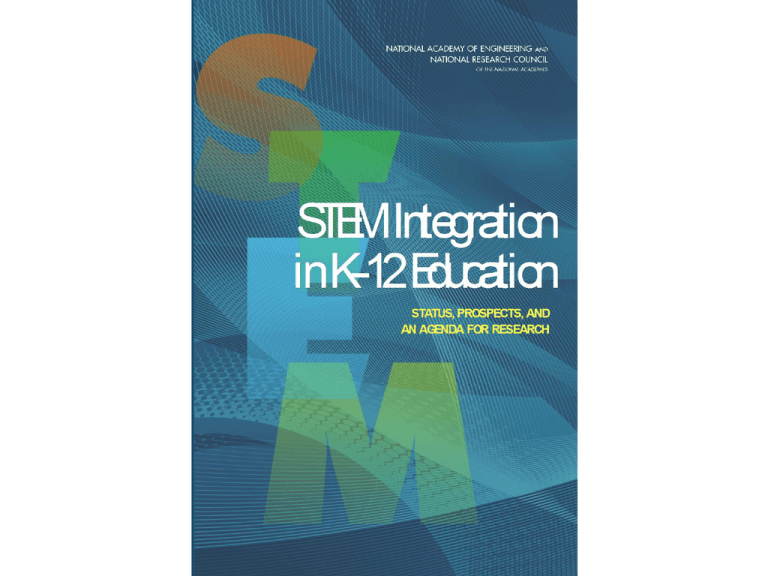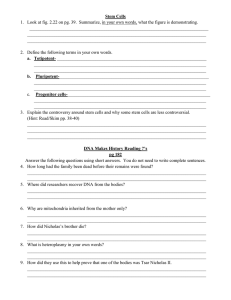Document 11671563
advertisement

COMMITTEE ON INTEGRATED STEM EDUCATION MARGARET A. HONEY (chair), New York Hall of Science, Queens LINDA ABRIOLA, Tufts University, Medford, Massachusetts SYBILLA BECKMANN, University of Georgia, Athens SUSAN HACKWOOD, California Council on Science and Technology, Riverside ALFRED L. HALL II, The University of Memphis, Tennessee JENNIFER HICKS, Purdue University, West Lafayette, Indiana STEVE KRAK, Ohio STEM Learning Network Battelle, Columbus BILL KURTZ, DSST Public Schools, Denver, Colorado RICHARD LEHRER, Vanderbilt University, Nashville, Tennessee BETH MCGRATH, Stevens Institute of Technology, Hoboken, New Jersey BARBARA MEANS, SRI International, Menlo Park, California DONNA MIGDOL, Oceanside School District, New York MITCHELL NATHAN, University of Wisconsin, Madison MARK SANDERS, Virginia Polytechnic Institute and State University, Blacksburg MICHAEL TOWN, Redmond High School, Duvall, Washington PROJECT STAFF GREG PEARSON, Study Director and Senior Program Officer, National Academy of Engineering HEIDI SCHWEINGRUBER, Study Codirector and Deputy Board Director, Board on Science Education, National Research Council JAY LABOV, Senior Advisor for Education and Communication, The National Academies CAMERON H. FLETCHER, Senior Editor, National Academy of Engineering MARIBETH KEITZ, Senior Program Associate, National Academy of Engineering REBECCA KRONE, Project Associate, Board on Science Education, National Research Council Why Integrated STEM? Align with how STEM is practiced in today’s world Prepare students for the requirements of the 21 century economy How the demand for skills has changed Economy-wide measures of routine and non-routine task input (US) Mean task input as percentiles of the 1960 task distribution Non-routine interactive Non-routine analytic The kind of things that are easy to test and teach are disappearing fastest Routine manual Routine cognitive Non-routine manual Traditional approaches to STEM learning have not worked well Framework for STEM Integration in K – 12 Education OUTCOMES For Students Learning and achievement 21st century competencies STEM course taking, educational GOALS persistence, and graduation rates For Students STEM-related employment STEM literacy STEM interest 21st century competencies Development of STEM identity STEM workforce readiness Ability to make connections among Interest and engagement STEM disciplines Making connections For Educators For Educators Increased STEM content knowledge Increased pedagogical content knowledge Changes in practice Integrated STEM Increased STEM content and pedagogical content knowledge Education IMPLEMENTATION NATURE AND SCOPE OF INTEGRATION Type of STEM connections Disciplinary emphasis Duration, size, and complexity of initiative Instructional design Educator supports Adjustments to the learning environment Ten Recommendations — Research, Outcomes, Design & Implementation, Assessment Research Recommendations R1. Research is best when there is: Rich description of intervention Alignment of study design and outcome measures with goals of intervention Control groups R2. The field — educators, program developers, researchers — could benefit greatly from a common framework for both description of the intervention and, when appropriate for the research strategy. Outcomes Recommendations R3. Avoid the “integrated STEM is good for everything” strategy. Delineate impact on achievement, interest, identity, persistence, etc. R4. Interest and identity. Examine long term impacts on diverse audiences Design and Implementation Recommendations OUTPUTS Quantity of work, products, and participants INPUTS Resources a program uses R6. Be explicit about teaching and Outcomes Activities Services Situation The context of the program • Organization’s mission • Audience needs R5. Delineate a logic model • Development and management tasks • Services to audience Change in target audience in knowledge, skill, attitude, behavior, status, condition EVALUATION learning goals R7. Understand learning goals and learning progressions Assessment Recommendations R9. Rethink assessment Assessment Recommendations R10. Embrace continuous improvement Goals and Instructional Objectives Design Desired Outcomes Implementation Results Intended Supports, Resources, Assessments/ Curriculum/Pedagogy and Enacted Measured Outcomes Curriculum/Pedagogy




